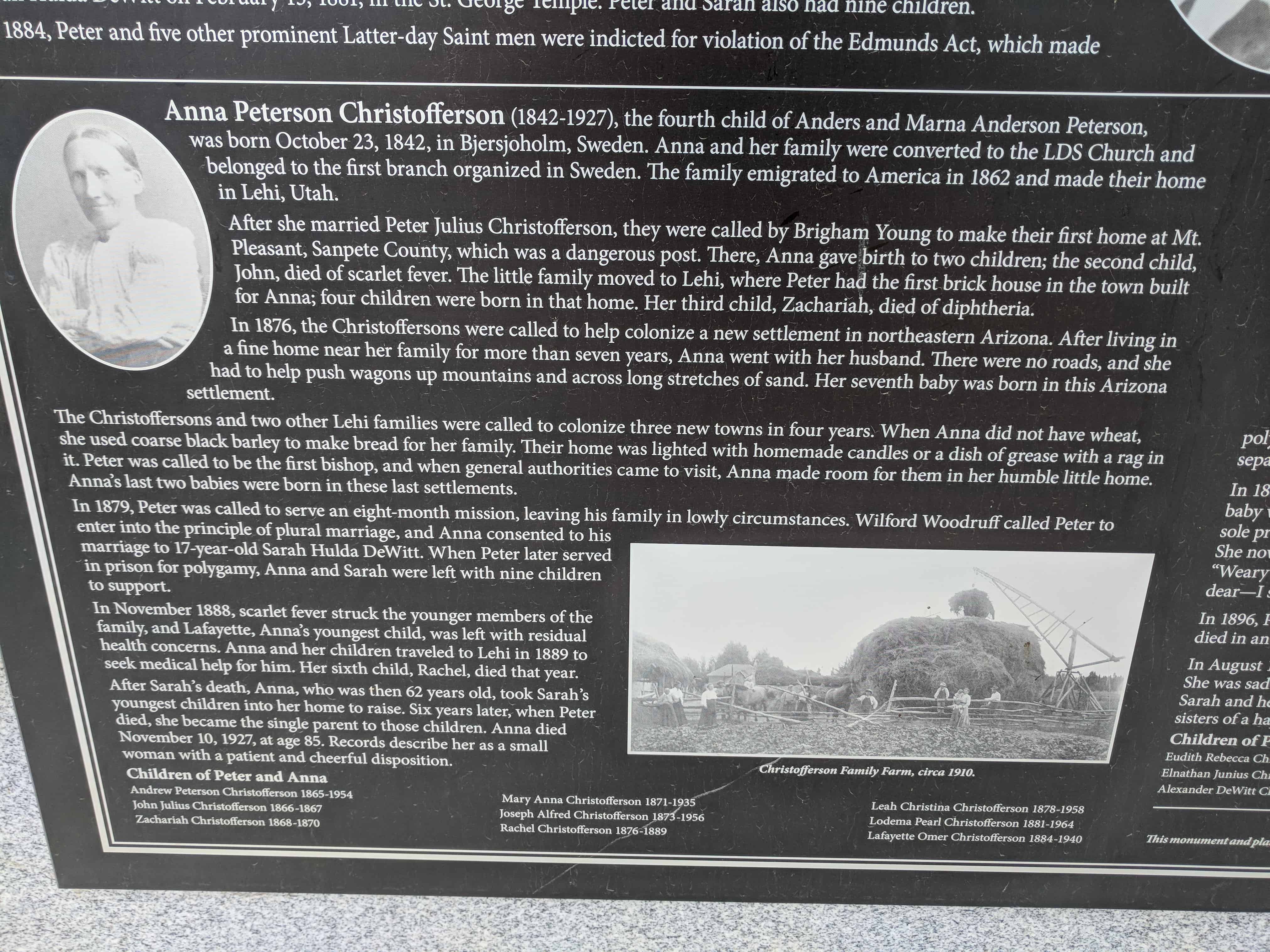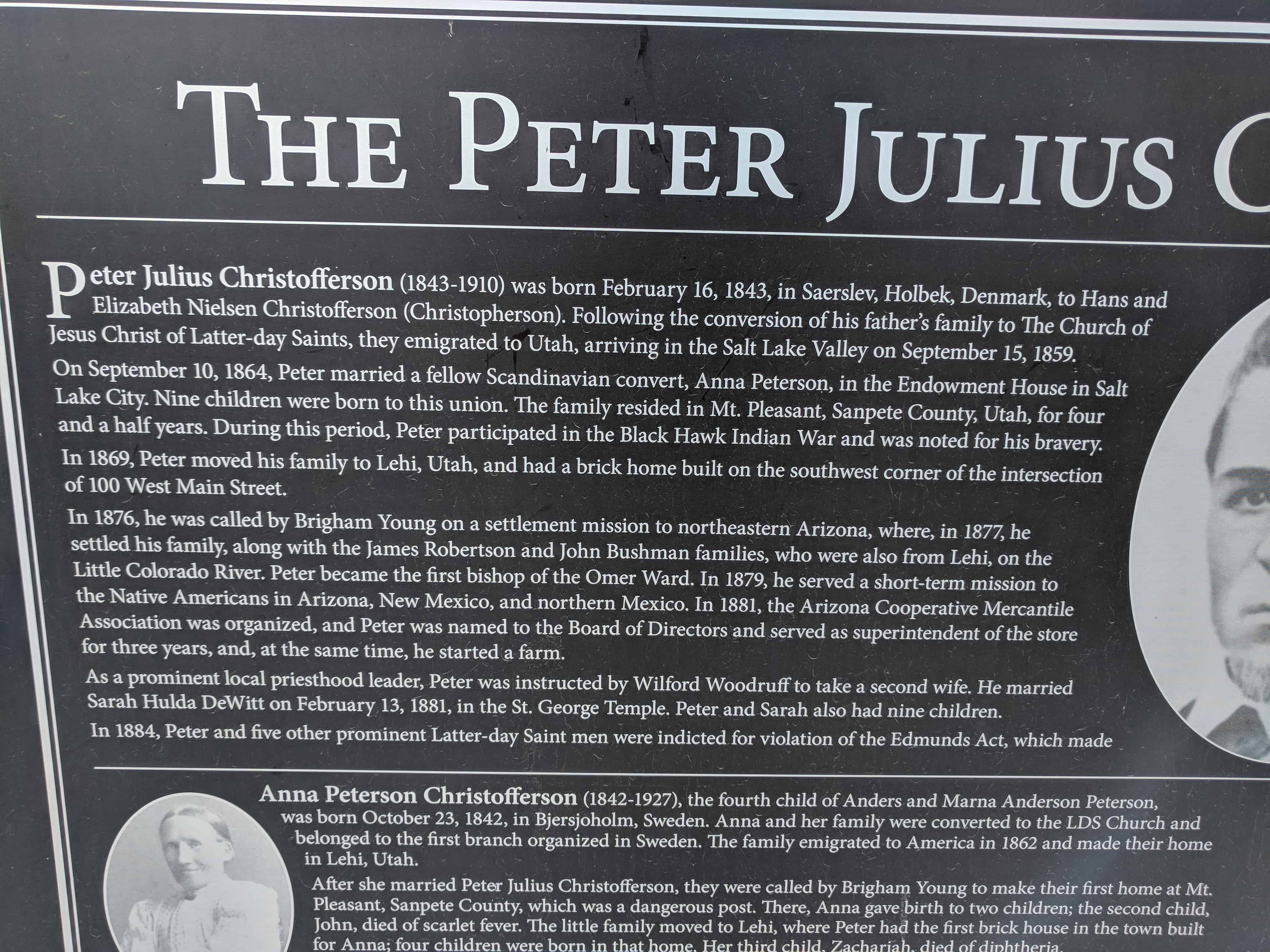Tags

The Peter Julius Christofferson Family
S.U.P. Marker #182 (other SUP Markers here.)
Location: 1525 North 600 East, Lehi, Utah

Peter Julius Christofferson (1843-1910) was born February 16, 1843, in Saersley, Holbek, Denmark, to Hans and Elizabeth Nielsen Christofferson (Christopherson). Following the conversion of his father’s family to The Church of Jesus Christ of Latter-day Saints, they emigrated to Utah, arriving in the Salt Lake Valley on September 15, 1859.
On September 10, 1864, Peter married a fellow Scandinavian convert, Anna Peterson, in the Endowment House in Salt Lake City. Nine children were born to this union. The family resided in Mt. Pleasant, Sanpete County, Utah for four and a half years. During this period, Peter participated in the Black Hawk Indian War and was noted for his bravery.
In 1869, Peter moved his family to Lehi, Utah, and had a brick home built on the southwest corner of the intersection of 100 West Main Street.
In 1876, he was called by Brigham Young on a settlement mission to northeastern Arizona, where, in 1877, he settled his family, along with the James Robertson and John Bushman families, who were also from Lehi, on the Little Colorado River. Peter became the first bishop of the Omer Ward. In 1879, he served a short-term mission to the Native Americans in Arizona, New Mexico, and northern Mexico. In 1881, the Arizona Cooperative Mercantile Association was organized, and Peter was named to the Board of Directors and served as superintendent of the store for three years,, and, at the same time, he started a farm.
As a prominent local priesthood leader, Peter was instructed by Wilford Woodruff to take a second wife. He married Sarah Hulda DeWitt on February 13, 1881, in the St. George Temple. Peter and Sarah also had nine children.
In 1884, Peter and five other prominent Latter-day Saint men were indicted for violation of the Edmunds Act, which made Polygamy a felony. He and two other men were sent to the Detroit House of Corrections for a term of three and a half years of hard labor. During his incarceration, he was a correspondent to the Deseret News, reporting on their condition as “a prisoner for conscience’ sake.” After serving nearly two years, the men received a hand-written pardon from President Grover Cleveland in October 1886. Upon his return to Arizona, he found that his farm had been taken over by land jumpers.
In 1889, Anna and her children, with the exception of Joseph, moved back to Lehi to get medical treatment for their son, Lafayette, who had contracted scarlet fever. Peter moved his and Sarah’s family to the Mormon colony in Colonia Diaz, Mexico, where they resided until 1896, when he moved the family back to Arizona. During these years, Peter traveled between the families. Sarah and her children moved by team and wagon to Lehi in 1900, reuniting the two families after an 11-year separation.
Peter resumed his business activities as a trader under the name of “PJ Christofferson & Sons” and was elected the first full-time marshal of Lehi. He was active in the LDS Church and was superintendent of the Sunday School for several years. Sarah and her children resided in a home at approximately 250 East 1350 North, while Anna and her children lived in a home at 1415 North 600 East.
Peter died February 3, 1910. His posterity now numbers in the hundreds, with many of his descendants prominent in civic, business, education, and religious fields. A great-grandson, Elder D. Todd Christofferson, was called to serve as a member of the Quorum of Twelve Apostles of The Church of Jesus Christ of Latter-day Saints in 2008.

Anna Peterson Christofferson (1842-1927), the fourth child of Anders and Marna Anderson Peterson, was born October 23, 1842, in Bjersjoholm, Sweden. Anna and her family were converted to the LDS Church and belonged to the first branch organized in Sweden. The family emigrated to America in 1862 and made their home in Lehi, Utah.
After she married Peter Julius Christofferson, they were called by Brigham Young to make their first home a Mt. Pleasant, Sanpete County, which was a dangerous post. There, Anna gave birth to two children; the second child, John, died of scarlet fever. The little family moved to Lehi, where Peter had the first brick house in the town built for Anna; four children were born in that home. Her third child, Zachariah, died of diphtheria.
In 1876, the Christoffersons were called to help colonize a new settlement in northeastern Arizona. After living in a fine home near her family for more than seven years, Anna went with her husband. There were no roads, and she had to help push wagons up mountains and across long stretches of sand. Her seventh baby was born in this Arizona settlement.
The Christoffersons and two other Lehi families were called to colonize three new towns in four years. When Anna did not have wheat, she used coarse black barley to make bread for her family. Their home was lighted with homemade candles or a dish of grease with a rag in it. Peter was called to be the first bishop, and when general authorities came to visit, Anna made room for them in their humble little home. Anna’s last two babies were born in these last settlements.
In 1879, Peter was called to serve an eight-month mission, leaving his family in lowly circumstances. Wilford Woodruff called Peter to enter into the principle of plural marriage, and Anna consented to his marriage to 17-year-old Sarah Hulda DeWitt. When Peter later served in prison for polygamy, Anna and Sarah were left with nine children to support.
In November 1888, scarlet fever struck the younger members of the family, and Lafayette, Anna’s youngest child, was left with residual health concerns. Anna and her children traveled to Lehi in 1889 to seek medical help for him. Her sixth child, Rachel, died that year.
After Sarah’s death, Anna, who was then 62 years old, took Sarah’s youngest children into her home to raise. Six years later, when Peter died, she became the single parent to those children. Anna died November 10, 1927, at age 85. Records describe her as a small woman with a patient and cheerful disposition.


I realize more fully now – my position on this earth – How I by Thee and aided – In any act of worth.

Sarah Hulda DeWitt Christofferson (1863-1904) was born March 26, 1863 at Big Cottonwood in Salt Lake City, Utah, to parents Abel Alexander DeWitt and Margaret Miller Watson, both Mormon converts. She cherished her childhood in the Salt Lake Valley by attending school in the winter and playing in fields in the summer.
Her father was called by LDS Church President Brigham Young to colonize the Little Colorado River area in northeastern Arizona. The family began their journey on November 10 1874. They arrived in Kanab, Utah, “as the sun was sinking” on January 1, 1875. For the first time, Sarah experienced poverty. The family lived in Kanab before moving south to Arizona in 1880.
When Sarah was almost 18 years old, she married Peter Julius Christofferson as his second wife. Sarah labored with Anna, the first wife, to create a home and live the gospel in a community that was hostile to polygamists. Sarah worked as a clerk in a store where Peter was manager. She gave birth to two children before her husband was sentenced to prison for polygamy. During his incarceration, she wrote, “We all did what our hands could find to do.” After Peter’s return, the two families lived in separate houses, and Sarah took in sewing to help provide for her children.
In 1889, to escape polygamy persecution, Peter moved Sarah and their children to the Mormon settlement of Colonia Diaz, Mexico. Her baby was only a few weeks old. Anna moved to Lehi, and Peter traveled between the two homes during the next 11 years. Sarah was often the sole provider for her children, selling milk from her cows, until the cows died of a disease. Later Sarah sold flour, which Peter left with her. She now had seven children. Sarah enjoyed serving in the stake young women’s organization. When Peter was away, Sarah got out her pen: “Weary worn and tired, dear pen I come again to thee…” She poured out her fears and frustrations by writing, “To me you all seem doubly dear – I seem to prize you better, and one thing more within my heart – I’ve learned to prize – a letter.”
In 1896, Peter moved Sarah and her children to Arizona to improve their living conditions. A short time later, the baby, Malcolm, tragically died in an accident. Another child was born in 1898.
In August 1900, Sarah and her children journeyed through the unsettled wilderness of Arizona and Utah with a horse team and a wagon. She was sad to leave her parents and siblings in Arizona, but there was a joyful reunion in Lehi for Peter’s two families. Peter made a farm for Sarah and her family on part of a vineyard in northeast Lehi. David Ward recalled that everyone ate and slept in both homes as “brothers and sisters of a happy family.” In 1902, Sarah gave birth to her ninth child. Sarah died on November 17, 1904.



